Marcus Ward & Co Ltd
Marcus Ward & Co Ltd – an international printer-publisher in Farringdon
Introduction
"'…pretty little books, which are both within and without treasures of artistic loveliness.'"
(Inverness Courier, 1891)
Charlotte Hopkins first came across Marcus Ward & Co printer-publishers when she acquired a small booklet entitled 'Golden Lamps' at an antiques fair. This beautifully decorated booklet was only 10 x 7.5 cm, small enough to fit in a pocket. She wondered what else they had produced and began a journey of discovery into their business and connection with London.
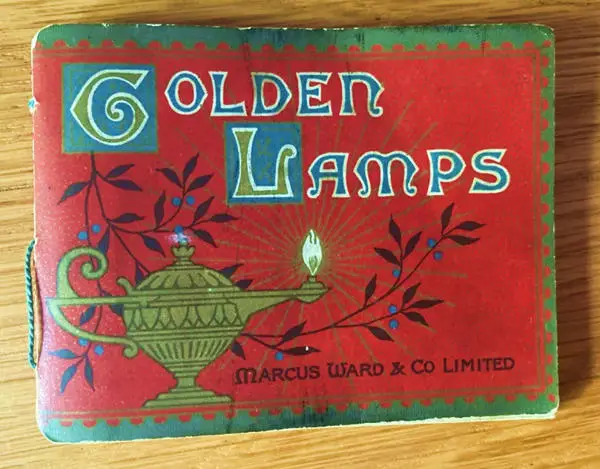
The main line of their business was in producing books and later greetings cards (in 1860s), diaries and calendars which were available at reasonable prices.
A glance at the British Library catalogue reveals that the company amassed a huge catalogue of publications over the course of their existence as ‘Ward and Company’ from the early 1800s until 1899. They received a medal at the Great Exhibition of 1851 in the Fine Arts Section for their colour lithography of which they were pioneers in the field. Marcus Ward had studied the possibilities of this new technology in the 1840s.
A family business
The origins of the company lay in Belfast when John Ward went into partnership in paper manufacture with Robert Greenfield and James Blow in 1802. John Ward formed a new company when this partnership ended in the 1820s. His sons Marcus and Francis managed the paper mills in Comber and Coleraine whilst the printing and stationery side were managed by their father. Marcus then took over the business in 1833 when his father retired. At this point the firm moved away from large-scale paper manufacture and advanced the printing and stationery part of the business.
Marcus Ward died at the age of 41 in 1847, but the success of the business continued to grow under his sons Francis David Ward and John Ward. John was interested in producing items of high artistic merit and organised art exhibitions on the premises. They had cutting edge technology with steam powered printing. In 1855, John Vinycomb, an authority on illuminating, became the artistic director. The business later had wider success from London and New York to Sydney.
Expansion to London
By 1867, the company had expanded to premises at 67 and 68 Chandos Street in Covent Garden which were managed by William Ward. A wide range of products were produced including the tear off calendar:
'Advertisements of the time give an indication of the full range of products, listing them as publishers, wholesale stationers and manufacturers, lithographers, artistic designers, illuminators, engravers, dye sinkers, embossers and bookbinders.' (Marcus Ward and Company of Belfast, D. Roger Dixon)
A directory from the 1870s refers to Marcus Ward & Co as ‘Booksellers’.
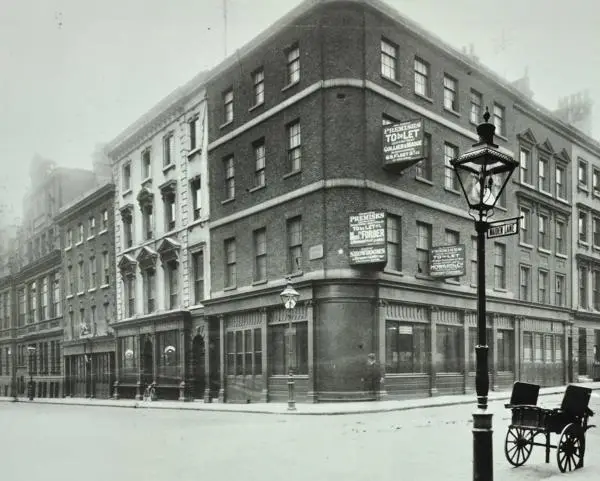
Chromolithography
The colour lithography process made it cheaper to produce items on a large scale and the company was the earliest mass producer of greetings cards. Within the first year, William employed the illustrator Kate Greenaway (1846-1901) at the London office to illustrate the cards. She worked for the company for ten years but left under a copyright dispute as the cards she had designed were not registered under her name at Stationers’ Hall. A popular feature of her work was children’s historical costumes, elaborate borders and fairies.
'Chromolithography was ideally suited to the reproduction or imitation of pages from medieval illuminated manuscripts, with areas of flat colour and extremely fine lettering...and in its early years it benefitted from the strong Victorian appetite for such delicacies.' (How to Identify Prints, Bamber Gascoigne).
An artist’s work
Next to take the role of artistic director was Thomas Crane (1843-1903) who was the older brother of the artist Walter Crane. Thomas '…specialised in flower decorations and ornamental borders and personally designed hundreds of cards for the firm.' (D. Roger Dixon)
Some of the books he illustrated included At Home (1881) along with J.G. Sowerby and Art Embroidery, A treatise on the revived practice of decorative needlework…With nineteen plates printed in colours from designs by Thomas Crane (1878).
Walter Crane also illustrated books for the company in the 1880s such as Slate and Pencilmania (1885), Little Queen Anne (1886), Pot Holes and Perseverance (1886). These colour-illustrated children’s books placed an emphasis on images over text and were referred to as ‘toy books’ which were popular in the Victorian period.
Whilst the London office remained the artistic centre, a large amount of the printing was undertaken in Belfast.
Marcus Ward illuminator to the Queen
The Company supplied illuminated addresses to the British Royal family and also Napoleon III and the Pope who were among some of their most notable customers.
In the collection at LMA is an illuminated book produced for the Corporation of London Holborn Valley Improvement Committee (CLC/295/MS03496) in 1869. This beautifully decorated volume has original watercolours for the design of Holborn Viaduct with illuminated borders signed by Marcus Ward and Co to coincide with its opening. Just over a decade later the Company would be located close-by to the Viaduct on Farringdon Street.
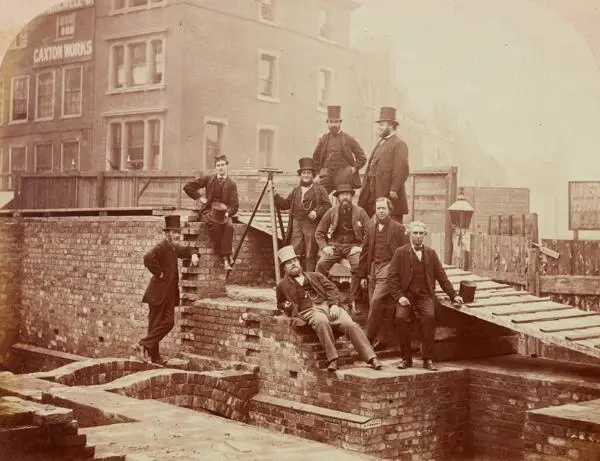
The influences of Medievalism, the Victorian love of the Gothic and Naturalism are clear in this example. At a time of industrial growth there remained a nostalgic attraction to the past. The Company produced, A Practical Treatise on the Art of Illuminating (1873) and within the volume it muses:
'The revival of the art of Illumination, which has recently taken place, is an important contribution to the refined civilization of our age. It is the resuscitation of a long-neglected source of beauty and enjoyment and adds a new and exquisite pleasure to the many which the present time affords.'
Holborn Viaduct volume
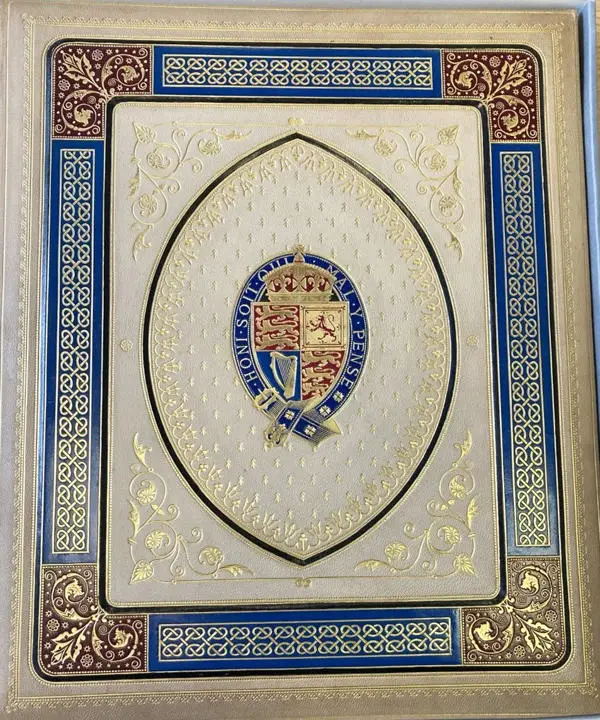
The front cover of the volume exquisitely sets the tone with gold embossed leather and decorative borders. A section of hand painted border displays thistle, acorn, Tudor rose and the shamrock of the company’s logo; the company were also adept armorial engravers.
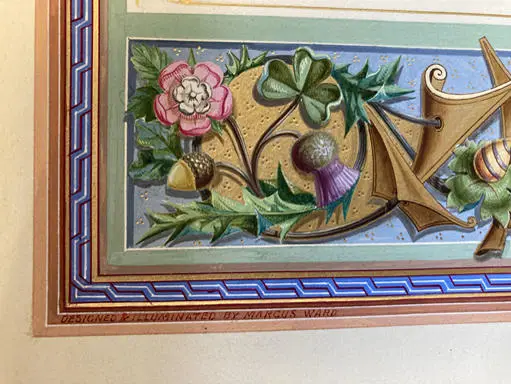
Oriel House
Oriel House at 30-31 Farringdon Street housed the firm from 1884. The name of the three-storey building was taken from the medieval inspired central feature of an oriel window. The Illustrated London News discussed the new building:
'The design for the building, executed in red brick and terra-cotta, was made in the London studio of the company by Mr Thomas Crane, who presides over the artistic staff there. The architect selected was Mr George Vickery, who intrusted the terra-cotta so freely used to Messrs. Doulton and Co of Lambeth. The building is spacious, admirably planned by the architect, and well lighted. The prominent high gable and red-tiled roof remind one of Amsterdam; while the style which is of no exact order, but might be called a ‘free Renaissance,’ shows that a City warehouse may be made a handsome building with an individuality that is most valuable to architectural effect.'
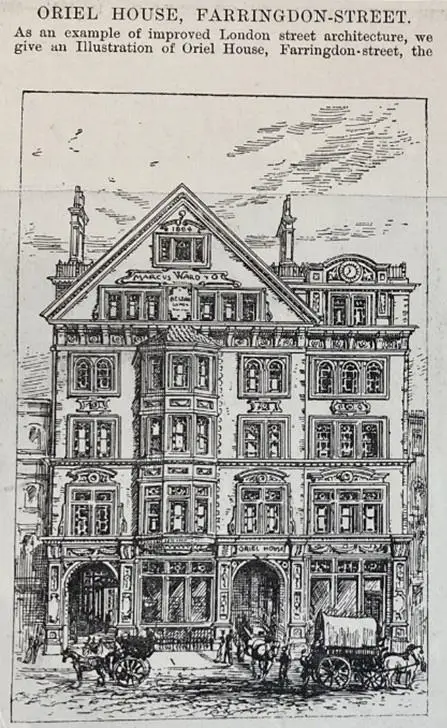
Upon the opening of the new premises there was an exhibition of the work produced by Marcus Ward and Co Ltd. including two-thousand watercolour drawings spanning a twenty-year period.
The same article reflects the successes of the business:
'They have been printers in colours since the lithographic colour process was first used in England, and their Christmas cards alone have gained them a high reputation for good taste. Their publications and the manufacturers of paper, leather, and other materials produced at the Royal Ulster Works, Belfast, give employment to a thousand workpeople, and are distributed over the world by the warehouses of the company in London, New York, and Melbourne.'
In this Goad Insurance Map (Vol II. Sheet 39) the firm is referred to as Marcus Ward & Co Publishers.
In an image from Historic England you can see an advert for Bovril etched on the windows of the ground floor of Oriel House. John Lawson Johnston (manufacturers of Bovril Limited) also leased part of the premises at 30 Farringdon Street alongside the Armourers’ Company and we hold a licence for alterations to the leasehold premises in E/BOV/XI/001 dated 7 Nov 1889. It states that Francis Davis Ward and William Hardcastle Ward were to lease the premises for a term of twenty-eight years from the 25 March 1884.
The building suffered bomb damage in the Second World War and has since been replaced by Lexis House. The site of Oriel House 30-31 Farringdon Street can be located next to Meridian House on the left in this photograph.
End of an era
After almost a century of printing and publishing, the firm of Marcus Ward and Co ran into difficulties and were beginning to compete with photographic reproduction processes. A committee of investigation was set up following the company's last annual general meeting, to find ways of saving the company, which had suffered from inefficient management. This was reported in The Insurance and Financial Gazette 1 March 1898 (CLC/B/002/10/01/053/008-009):
'The reorganization provides for the prompt removal of serious difficulties with which in the past the company have had to contend, and we are happy in the belief that days of prosperity are in store for the shareholders. We congratulate the company upon the happy turn affairs have taken. Cordially we wish the reorganised concern, as a great employer of labour, as a company of eminence and importance, every success.'
Unfortunately, this success was not to be, and the business ceased in 1899.
'In 1899 the company admitted defeat and wound up the business, paying off all creditors and shareholders in full. One thousand four hundred men the majority of them skilled craftsmen lost their jobs and a company that had made Belfast world famous was no more. The rival Belfast firm, McCaw, Stevenson and Orr, acquired the rights to the Marcus Ward name in 1900 and continued to use it for a range of products right until World War II.' (D. Roger Dixon)
Directories in 1910 show Marcus Ward & Co. Almanack Printers at 31 & 32 Shoe Lane in the City of London.
Further reading and resources
- Marcus Ward and Company of Belfast, D. Roger Dixon (Belfast: Belfast Education and Library Board, c.2004)
- Biography of Marcus Ward
- Worshipful Company of Stationers
- Historic England